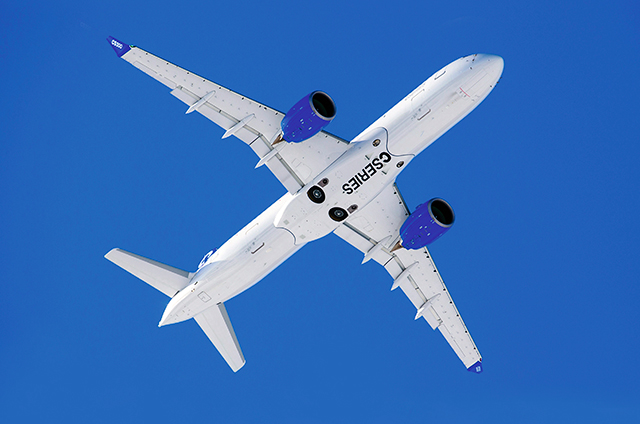Bombardier’s China strategy has pushed the envelope, but has not seen a payoff yet. The Canadian airframer has sold a number of CRJ regional jets in the country, but is still struggling to find a solid footing for its CSeries family.
Early on, the company moved to find an ally in Comac, hoping that such a partnership would help the CSeries sell in China.
The duo signed an agreement to develop commonality between the CSeries and the in-development C919 narrowbody. They even wanted to make the look and feel of the two jets’ cockpits similar, to reduce training and maintenance costs for airlines that bought both. They would also work together on sales and marketing to jointly pitch the aircraft to customers.

Bombardier
It has been four years since the pair came together, but little movement has occurred. Cockpit commonality never emerged, given the different timelines of the CSeries and C919, and there is no marketing alliance to speak of.
Still, Bombardier has plugged away. It has a letter of intent with Loong Air for 20 CS100s. CDB Leasing also has a conditional agreement to buy 15 CSeries aircraft, with options for a further 15. The agreement with Loong Air was signed in 2014, and that with CDB Leasing in 2012, but neither has been firmed.
At the Farnborough air show in July, the manufacturer told FlightGlobal it was also in talks with several Chinese airlines on the CSeries, with “proposals on the table”, and revealed a target to win a deal within 12 months. The big four airlines – Air China, China Southern Airlines, China Eastern Airlines and Hainan Airlines – are among those it is in discussions with.
Its challenge, the Canadian manufacturer says, is in its lack of a large installed base in the country. Bombardier recognises that in addition to a customer base, Boeing and Airbus also have established support and training networks in the region, which it needs to catch up on.
Andy Solem, Bombardier’s vice-president of sales in China and Asia-Pacific, says: “Seeing is believing. We’ve got to get some aircraft out there, get some infrastructure in place, which we can do. We just need an operator.”

Bombardier has had some success with its CRJ-family regional jets, with Chongqing-based China Express Airlines operating 26 examples
AirTeamImages
Analysts believe that for the 110- to 160-seat CSeries to gain traction in China, secondary routes need to grow in importance, and airlines need to better tailor the aircraft in their fleet to the mission.
Ray Jaworowski, senior aerospace analyst at Forecast International, says: “Through marketing and sales campaigns, Bombardier needs to convince Chinese carriers and other airlines in the Asia-Pacific region of the economic and efficiency benefits of using optimally sized jetliners such as the CSeries on many routes currently served by too-large narrowbody airliners that often fly with excess capacity.”
Growth in China has been so phenomenal that airlines have no qualms about going big, usually first considering trunk routes that call for larger aircraft, rather than regional jets. Even start-ups boldly induct shiny new Airbus A320s and Boeing 737s.
Flight Ascend Consultancy’s Richard Evans says congestion at major Chinese airports is also likely to drive aircraft size upwards, which means the CSeries will struggle to gain traction in the country.
“There are definitely some markets where a 130-150 seater is the right size, but Bombardier will face intense competition for orders, not just from Airbus and Boeing, but from the C919 too,” he adds.
The Flight Fleet Forecast predicts deliveries of 155 CSeries aircraft to China from 2021 to 2035. While a reasonable figure, this is marginal compared with the combined 4,500 forecast for A320s and 737s.
Bombardier feels that massive narrowbody order backlogs have depressed CSeries opportunities.
“There is a glut – they have ordered a lot of 737s and A320s – so that is going to take some time to absorb,” says Bombardier’s senior vice-president commercial Colin Bole. “My sense is there has been a little bit of over-order by the Asian airlines, and there is a process of absorption and digestion, and maybe some restructuring too.”
Bole hopes that successful service entries for the CSeries with Swiss and Air Baltic this year will “get the momentum going in China”. He may have a point: Chinese carriers are cautious about new types, preferring to witness an aircraft’s stable service entry before signing up.
With the Comac tie-up achieving less than hoped, Bombardier may need more drastic action to find success in the giant market.
At the 2014 Zhuhai air show, the airframer said building a final assembly line in the country could be “the next logical step”.
With a large amount of manufacturing for its Q400 and CSeries already being done in China, Bombardier’s former president Mike Arcamone said the next step would be “to put all parts together, not only a final completion centre, but a real final line where we do the full assembly”.
This would be a bold move, but would only makes sense if orders justified it. Moreover, Bombardier now also has a new shareholder to consider, with the Quebec government having pumped $1 billion into the CSeries programme. The idea of Bombardier moving Canadian jobs overseas is not one that such a shareholder would relish.
Source: Flight International






















